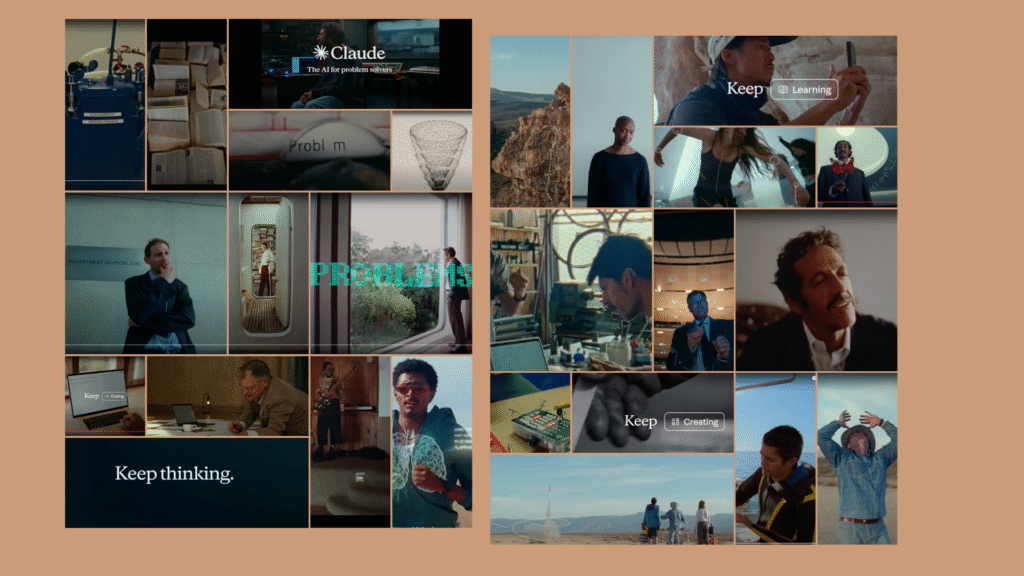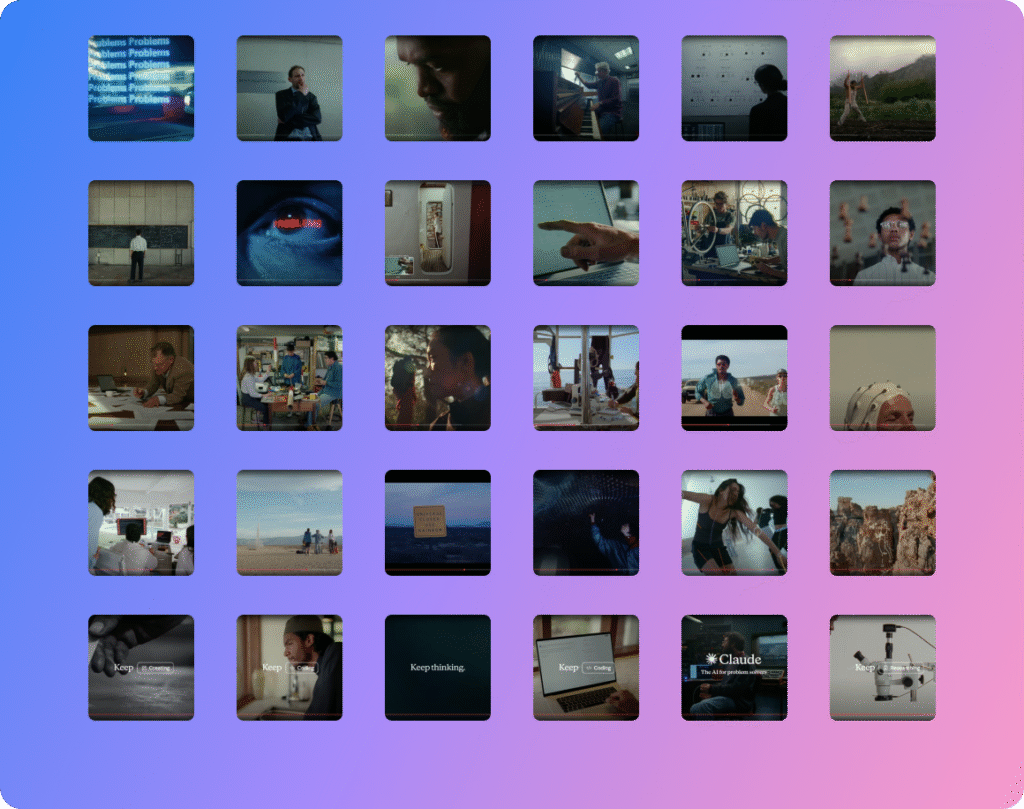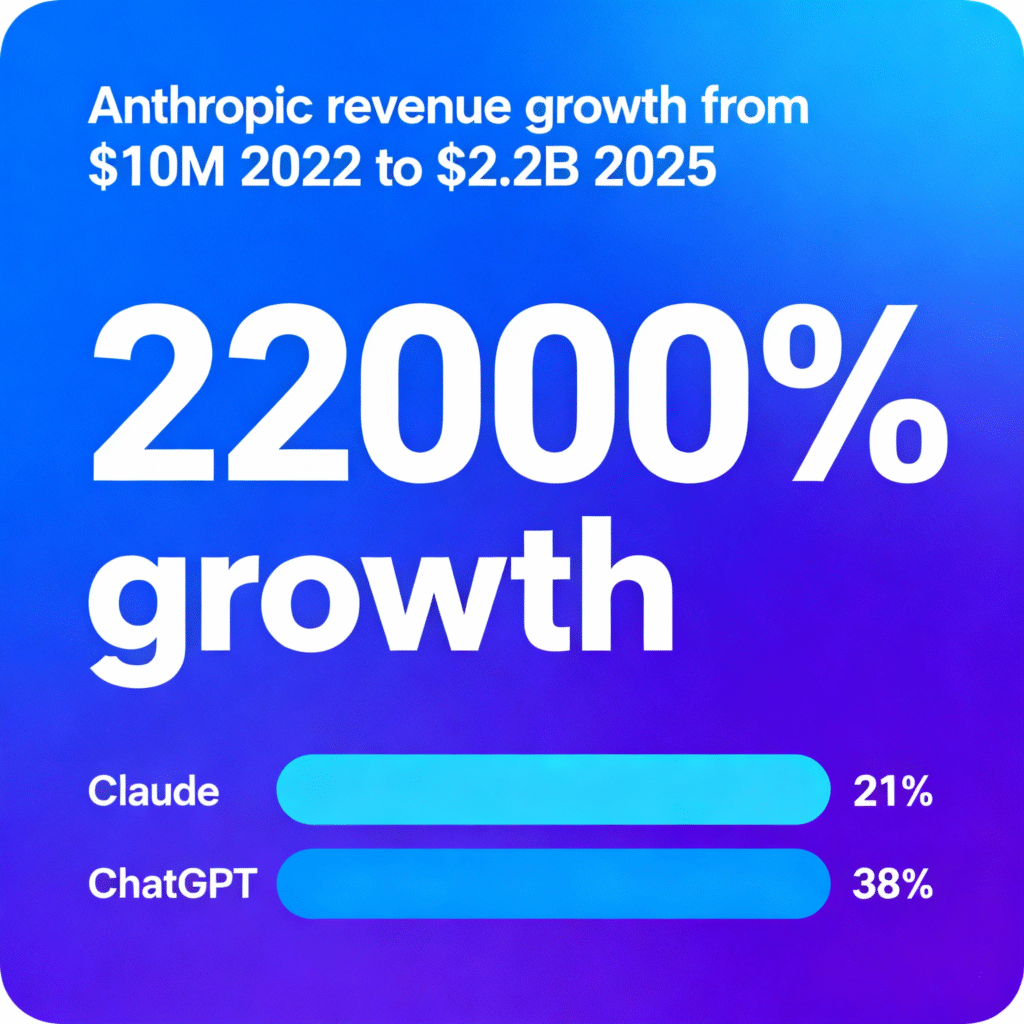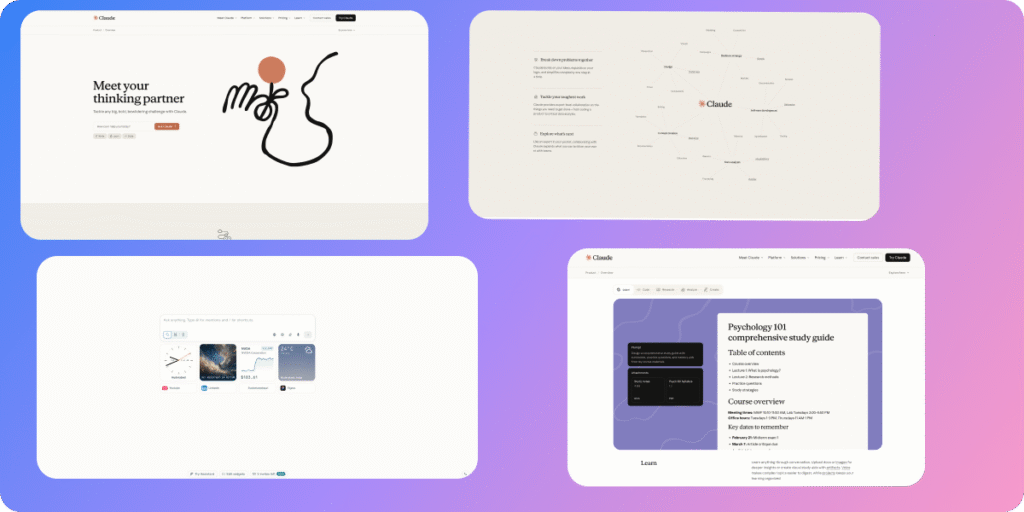The marketing demigods have presented to us yet again – another AI advertisement. Anthropic’s debut brand campaign for Claude landed this September—a 90-second film positioning AI as humanity’s thinking companion.

But does it actually work? Let’s dissect what went right, what reveals sophisticated strategy, what didn’t quite land, and how this campaign reflects both the promise and pitfalls of modern AI marketing. Plus, if I ever get my hands on a campaign this scale (or for my own agency dreams), here’s what I’d do differently.
The Opening Gambit: Genius Disguised as Confusion

The campaign opens with a paradox. “There’s never been a worse time,” it declares, before pivoting to optimism about having problems to solve. It’s Churchill meets Silicon Valley—and the execution is far more sophisticated than it first appears.
What initially seems like tonal whiplash actually demonstrates strategic emotional intelligence. Neuroscience research shows that brains make critical viewing decisions within three seconds. But here’s the genius: the opening doesn’t confuse—it validates.
The paradox serves a purpose. It acknowledges the collective anxiety professionals feel about AI disruption, then reframes problems as opportunities for partnership rather than replacement.
Need help crafting messaging that acknowledges real concerns? Explore UX and Microcopy services.
What Worked Brilliantly
Emotional authenticity over corporate sanitisation. Most tech companies avoid acknowledging user anxiety. Anthropic leans into it, creating immediate credibility.
Strategic vulnerability. The stammering repetition in the transcript—”There’s never been a worse night problem”—mirrors how people actually feel when overwhelmed.
It’s brave creative work.
Cultural zeitgeist reading. In 2025, everyone feels the weight of information overload and accelerating change. The campaign validates this shared experience.
What Missed the Mark
Execution clarity sacrifice. Whilst the emotional strategy works, the opening sequence demands too much cognitive processing. Many viewers I fear will bounce before reaching the payoff.
Brand recall risk. The abstract opening might be memorable for wrong reasons—confusion rather than connection.
The Numbers Game: Context That Changes Everything

Before we dive deeper, consider Anthropic’s remarkable trajectory. The company has grown from $10 million revenue in 2022 to a projected $2.2 billion in 2025. That’s a 22,000% increase.
Yet timing matters. This campaign launched when Claude holds 21% of global LLM usage—impressive, but user growth actually declined 15% from November 2024 to January 2025.
So this isn’t just brand building. It’s retention and recovery.
What Marketing Strategy Gets Right (And Where It Falters)
The multi-million pound investment spans everything from The New York Times to Netflix. It’s comprehensive omni-channel marketing with cultural intelligence.
The Smart Strategic Choices
Target audience precision. The campaign targets “problem solvers”—developers, researchers, business owners. Anthropic’s data confirms Claude is predominantly used for work-related tasks.
Authentic casting triumph. Featuring real Anthropic researchers adds credibility. No stock photos, no generic tech workers. Actual humans doing actual work with genuine passion.
Enterprise momentum capitalisation. The timing leverages Anthropic’s 32% enterprise market share—a sharp reversal from OpenAI’s previous dominance.
Cultural empathy demonstration. The anxiety acknowledgment shows sophisticated understanding of current professional zeitgeist.
Want to build similar strategic foundations? See Strategy and Planning services.
The Missed Opportunities
Technical differentiation underplayed. Constitutional AI represents genuine competitive advantage, but the campaign barely hints at it. Enterprise buyers need concrete reasons to switch beyond emotional appeal.
Visual language derivation. Users immediately noted similarities to Apple’s “Think Different” campaign. In crowded AI advertising space, this feels unimaginative.
Regional customisation absent. India represents 17.37% of global traffic, yet no cultural localisation visible.
The Copy Revelation: Authentic Voice Discovery

The transcript reveals apparent repetition issues:
“There’s never been a worse night problem. There’s never been a worse night problem. There’s never been a worse night.”
What Actually Works Here
Emotional authenticity. The stammering reflects genuine overwhelm—how people actually feel when facing complex problems. It’s brave creative choice that validates user experience.
Anxiety acknowledgment strategy. Rather than corporate confidence, this shows vulnerability that builds trust.
Psychological mirroring. The repetitive structure mirrors anxious thought patterns, creating subconscious connection.
Need script strategy that balances authenticity with clarity? Explore UX Writing expertise.
The Tagline Triumph
“Keep Thinking” represents pure strategic brilliance. It positions Claude as collaborative rather than replacement—crucial when AI replacement anxiety runs high.
The tagline succeeds because it’s:
- Active (encouraging behaviour)
- Inclusive (suggesting collaboration)
- Reassuring (humans remain central)
- Distinctive (avoids “faster/smarter/better” commoditisation)
The AI Positioning Breakthrough (With Room for Enhancement)

Anthropic positions itself as the “responsible AI” company. The campaign demonstrates this through emotional intelligence rather than just declaring it.
Research confirms trust and compatibility drive AI adoption more than raw capability. The anxiety-first approach builds trust foundation.
What Works Strategically
Philosophy demonstration over declaration. Instead of claiming responsibility, the campaign shows empathetic approach to user concerns.
Collaborative positioning success. “Thinking partner” messaging directly addresses replacement anxiety.
Enterprise psychology understanding. Business users appreciate vendors who acknowledge their concerns rather than dismissing them.
The Gaps That Matter
Technical capability underemphasis. Constitutional AI, 200,000 token context window, enterprise security features—these differentiators get buried under emotional messaging.
Concrete use case absence. Emotional appeal needs functional demonstration for B2B conversion.
Competitive advantage articulation. Why choose Claude specifically? The campaign creates trust but doesn’t close the rational sale.
The Agency Success: Mother London’s Cultural Intelligence
Mother London demonstrates their reputation for cultural relevance. Their philosophy—“work that takes the world into account”—shines through the anxiety acknowledgment approach.
Creative Excellence Achieved
Cultural zeitgeist capture. The opening perfectly reflects 2025’s professional anxiety about AI transformation.
Authentic emotion over corporate polish. Rare courage to show vulnerability in tech advertising.
Strategic differentiation. Emotional maturity creates clear competitive separation.
Execution Challenges
Art direction borrowing. Visual similarity to iconic campaigns undermines originality claims.
Message clarity versus artistic vision. The balance tips too far toward abstract creative at expense of immediate comprehension.
Market Context: Strategic Differentiation Success
The competitive landscape shows every AI company claiming “responsibility.” But Anthropic’s approach differs by demonstrating emotional intelligence rather than declaring ethical superiority.
Current positioning reality:
- OpenAI: Capability and accessibility focus
- Google Gemini: Integration and intelligence emphasis
- Microsoft Copilot: Productivity enhancement messaging
Anthropic’s anxiety-acknowledgment positioning represents sophisticated differentiation through emotional maturity.
What This Achieves
Trust building in crowded market. When everyone claims responsibility, emotional authenticity creates genuine differentiation.
Enterprise appeal amplification. B2B buyers appreciate vendors who understand transformation anxiety.
Cultural intelligence demonstration. Shows deep market understanding beyond feature comparison.
Need help developing emotionally intelligent positioning? Explore Strategic Planning services.
The Measurement Challenge: Beyond Vanity Metrics
Effective measurement requires understanding both immediate response and long-term trust building.
Current Performance Indicators
Positive signals:
- Significant earned media coverage with favourable sentiment
- Social media engagement depth beyond surface metrics
- Enterprise inquiry quality improvements
- Competitor switching conversation increases
Concerning patterns:
- 15% user growth decline during campaign period suggests awareness-conversion gap
- Visual similarity criticism indicates creative execution issues
Want sophisticated campaign measurement? See Email and Campaigns services.
How I’d Approach It Differently (Agency Dreams Edition)
If I ever get the chance to work on campaigns this scale—or build my own agency to this level—here’s what I’d do differently whilst maintaining the emotional intelligence that works.
Strategic Foundation Enhancements
Dual-track messaging approach:
- Track 1: Emotional anxiety acknowledgment (keep this brilliance)
- Track 2: Concrete capability demonstration (add this missing piece)
Phased storytelling structure:
- Phase 1: “We understand your concerns” (current strength)
- Phase 2: “Here’s specifically how we help” (missing component)
- Phase 3: “This is why Claude specifically” (competitive closure)
Creative Execution Refinements
Opening sequence optimisation:
- Maintain anxiety acknowledgment concept
- Reduce cognitive processing load
- Add visual clarity cues
- Test comprehension versus emotional impact
Visual identity independence:
- Develop distinctive creative language
- Avoid iconic campaign borrowing
- Create original cultural reference points
- Build Anthropic-specific aesthetic vocabulary
Want to see how strategic design creates distinctive brand identity? Explore Design and Visual Identity services.
Content Strategy Expansion
Use case integration without sacrificing emotion:
- Split-screen storytelling: Anxiety acknowledgment paired with solution demonstration
- Real user journey mapping: Show actual Claude collaboration moments
- Progressive disclosure: Emotional connection first, then functional proof
Technical differentiation weaving:
- Constitutional AI explanation through emotional lens
- Context window demonstration via relatable scenarios
- Enterprise security through trust-building narrative
Regional Intelligence Implementation
Cultural adaptation strategy:
- India market: Acknowledge transformation pace anxiety specifically
- Europe focus: Emphasise responsible development heritage
- US positioning: Highlight enterprise security and compliance leadership
Localised emotional triggers:
- Different professional anxiety expressions across cultures
- Region-specific collaboration expectations
- Varied AI adoption concern patterns
The Neuroscience Advantage: What Science Says
Recent research reveals the campaign’s neurological effectiveness potential.
Successful brain activation patterns:
- Emotional validation triggers trust centres before rational processing
- Anxiety acknowledgment activates social bonding mechanisms
- Partnership framing engages collaboration neural pathways
Brain response research suggests the emotional-first approach aligns with optimal neural processing for technology adoption.
Where Neuroscience Supports the Strategy
Validation-first processing. Acknowledging concerns before proposing solutions aligns with how brains actually evaluate new technology.
Trust building through vulnerability. Showing uncertainty creates authentic connection that facilitates adoption consideration.
Collaborative activation. “Thinking together” messaging triggers partnership neural pathways rather than competition responses.
Neurological Optimisation Opportunities
Clarity enhancement. Emotional authenticity shouldn’t sacrifice message comprehension—both can coexist with better execution.
Visual processing support. Abstract artistic choices should support rather than hinder emotional message reception.
Cultural Context: Reading the Professional Zeitgeist
The campaign demonstrates sophisticated understanding of 2025’s professional landscape: simultaneous fascination with AI potential and legitimate concerns about workplace transformation.
Current professional anxieties include:
- Role transformation uncertainty
- Skill obsolescence fears
- Quality and reliability concerns
- Human agency preservation needs
The campaign’s anxiety-first approach directly addresses these concerns rather than dismissing them.
Cultural Intelligence Success
Zeitgeist acknowledgment. The opening perfectly captures how professionals actually feel about AI transformation.
Empathy over optimism. Choosing vulnerability over corporate confidence shows market sophistication.
Partnership positioning. Addressing replacement anxiety directly rather than avoiding the topic.
For culturally intelligent global strategy development, explore SEO and Digital Copy services.
The Strategic Success (With Enhancement Potential)
This campaign represents mature AI brand marketing that prioritises emotional intelligence over feature comparison. It acknowledges real concerns whilst positioning Claude as collaborative partner.
What Succeeds Brilliantly
- Anxiety acknowledgment builds immediate trust through authentic vulnerability
- Emotional validation approach aligns with actual technology adoption psychology
- Cultural zeitgeist awareness demonstrates sophisticated market understanding
- Partnership positioning directly addresses core replacement concerns
- Authentic casting strategy reinforces collaborative rather than threatening messaging
Strategic Enhancement Opportunities
- Technical capability integration without sacrificing emotional foundation
- Visual identity independence from established creative tropes
- Concrete demonstration balance to complement emotional appeal
- Regional cultural adaptation for global market optimisation
- Conversion pathway clarity from awareness to trial to adoption
My Alternative Approach Framework
Phase 1: Emotional Foundation (Keep the Brilliance)
Opening concept: Maintain anxiety acknowledgment but with clearer execution
Emotional authenticity: Keep vulnerability but add comprehension support
Cultural intelligence: Expand global sensitivity implementation
Phase 2: Capability Integration (Add Missing Piece)
Technical demonstration: Show Constitutional AI through emotional lens
Use case revelation: Real collaboration moments without corporate sterility
Competitive advantage: Why Claude specifically, through trust-building narrative
Phase 3: Conversion Optimisation (Close the Gap)
Trial encouragement: From emotional connection to actual usage
Success measurement: Beyond awareness to retention and advocacy
Feedback integration: User experience validation of partnership messaging
Want to see comprehensive campaign strategy development? Explore services at suchetanabauri.com.
The Final Analysis: Sophisticated Strategy with Execution Gaps
The campaign succeeds in establishing Claude as emotionally intelligent AI partner that acknowledges rather than dismisses user concerns. This represents advanced brand strategy that treats technology adoption as human experience.
In marketing, empathy combined with capability often triumphs over features alone—and this campaign demonstrates courage to lead with empathy whilst having opportunity to better integrate capability proof.
Anthropic’s approach shows mature understanding of AI adoption psychology. The emotional foundation works brilliantly; the execution and capability integration offer enhancement opportunities.
For a company growing at 22,000% revenue rates whilst maintaining responsible development principles, this campaign aligns creative strategy with brand values. It’s sophisticated work that establishes strong foundation for future capability-focused communication.
If I ever get to work on campaigns this scale—or build my own agency to this level—this represents the kind of strategic thinking I’d want to enhance rather than replace.
The campaign succeeds in positioning Claude as collaborative thinking partner that understands rather than dismisses legitimate AI concerns. That’s valuable strategic positioning that many competitors struggle to achieve.
In the attention economy, emotional authenticity opens doors that capability claims alone cannot.
For strategic marketing insights that balance emotional intelligence with technical capability—and maybe someday campaign opportunities at this scale—visit suchetanabauri.com.
References
- Axios. “Anthropic launches first brand campaign for Claude.” Campaign launch coverage
- PNAS. “Brain activity forecasts video engagement.” Neuroscience research
- TapTwiceDigital. “Anthropic Statistics 2025.” Growth trajectory data
- SQ Magazine. “Claude AI Statistics: Market Share & Trust.” Market position analysis
- Creative Salon. “Anthropic Positions Claude as Problem Solver’s AI.” Creative strategy coverage
- Adweek. “Claude Makes First Big Ad Play.” Marketing strategy analysis
- TechCrunch. “Enterprises prefer Anthropic’s AI models.” Enterprise adoption research
- Reddit. “Anthropic new ad discussion.” User reaction analysis
- Nature. “EEG Spectral Dynamics of Video Commercials.” Video effectiveness research
- Human Factors in Healthcare. “AI-Based Well-Being Applications Research.” User behaviour insights
- Creative Review. “Most Creative Advertising Agency: Mother.” Agency profile and philosophy
- DemandScience. “Ways to Measure Campaign Success.” Measurement methodology guide
- AMA. “How Neuroscience Can Predict Ad Enjoyment.” Consumer psychology research
- US Data Corporation. “Neuroscience of Effective Marketing.” Brain response studies
- Analyzify. “Latest Anthropic Statistics.” Global market data
- Science Direct. “Users’ behaviour with task-oriented Chatbots.” Adoption pattern research
